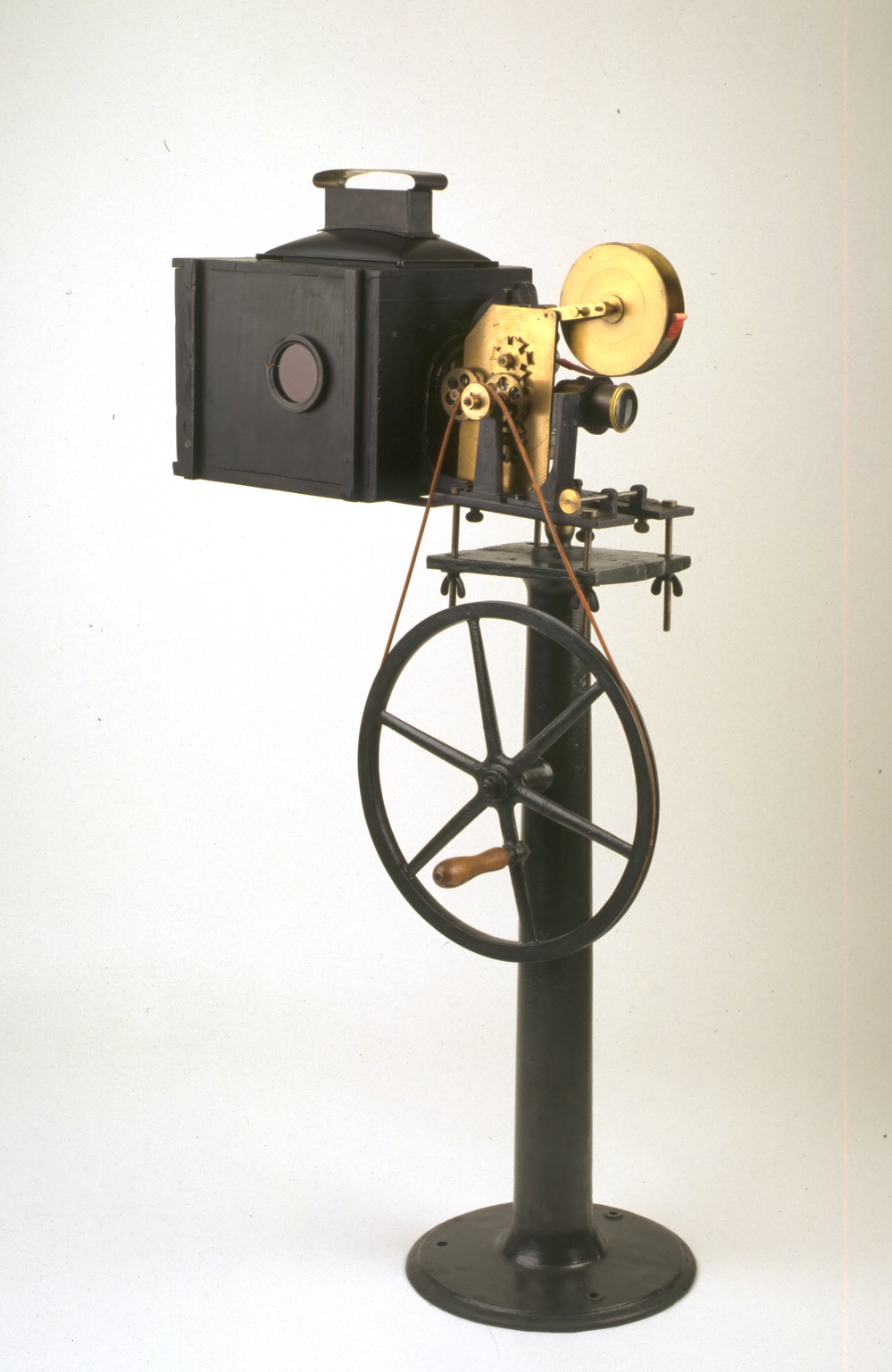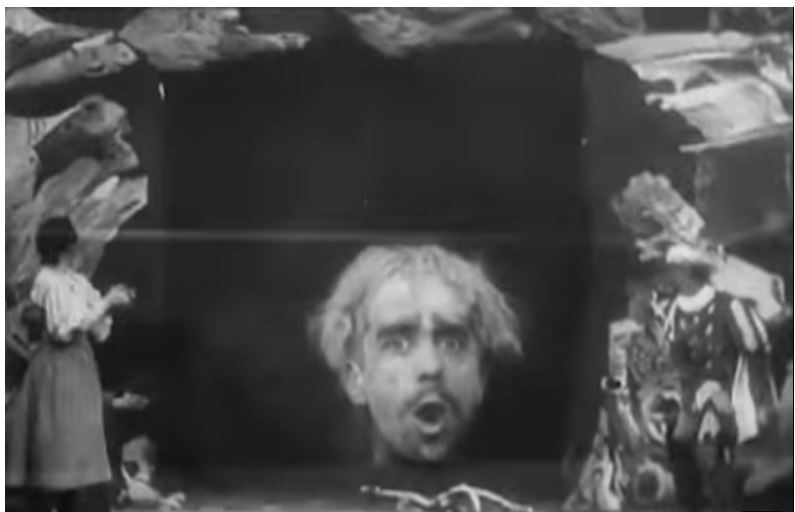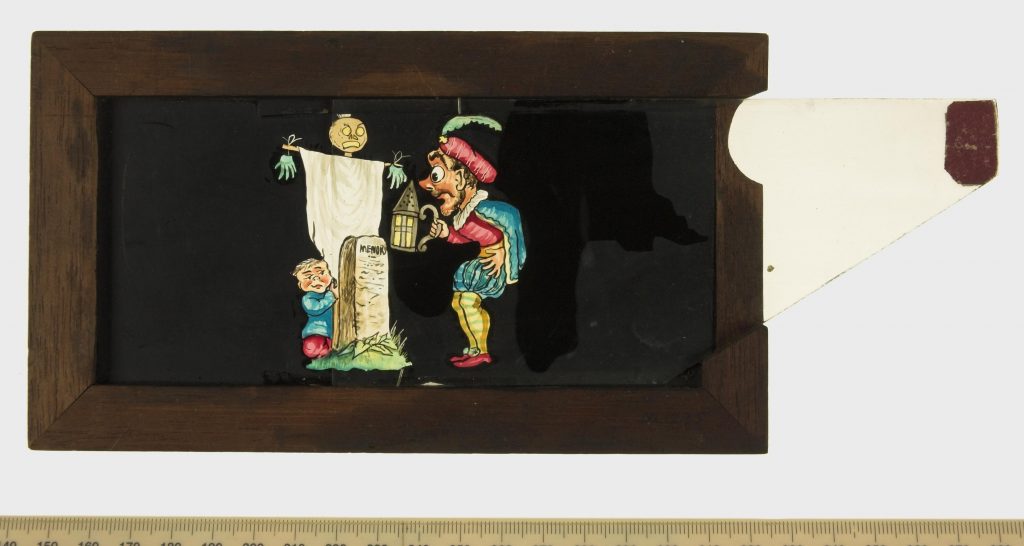Before the arrival of cinema, magicians were already making use of projected images in their acts, primarily through the use of magic lanterns. But of course, audiences would probably not have realised this—magic performers were secretive about their methods and would use lanterns covertly for spectacular effects.
The slides used included pictures of spooks and spectres, some designed to frighten…

Others to amuse…
Along with images of wizards wielding their magical powers in the time-honoured way.

(If the lever at the side is pulled, the wizard’s arm moves and he waves his wand.)
When moving pictures became part of the regular entertainment available to the British public, it was usually in theatres and music halls as part of a bill of varied entertainments. The films would make up a portion of the show and include narration, acting, sounds or musical accompaniment.
The existing popularity of such variety venues helped to embed moving pictures within the public’s idea of entertainment—especially when used by magicians themselves.
One of the most eminent magic venues in England was the Egyptian Hall. Built in 1812 as a natural history museum, it also displayed curiosities from around the world such as conjoined twins, ‘living skeletons’ and ‘half-human half animals’.

Towards the end of the 19th century, the Hall had become particularly associated with magic and spiritualism. In 1873, John Nevil Maskelyne and George Alfred Cooke began performing there and did so for the next 31 years, during which time it became known as ‘England’s Home of Mystery’.
Maskelyne was always very clear that his work was illusion and conjuring: while protecting his methods, he never claimed any supernatural or spiritual powers.

Magician David Devant (1868–1941) joined the Egyptian Hall in 1893. He was already a very familiar name to the public as he had travelled extensively throughout the country with his magic shows and continued to do so into the 20th century—including to Bradford, as the writer J.B. Priestley recalled:
“Mr Devant remains in my memory as a true magician, a wizard. Twenty years ago, when I was still in my teens, I conceived the audacious plan of taking my father, who did not care much for variety shows, to the old Bradford Empire. Well, I was lucky, for it happened that splendidly be-topping the bill was no less a person than Mr Devant. My father and I were enchanted by him. He produced eggs—not a few eggs, but hundreds and hundreds of eggs, until it looked as if the stage were about to turn into one vast omelette.”
(Part of Priestley’s introduction to Devant’s autobiography My Magic Life, 1931)
The first public shows of projected moving pictures in Britain were conducted by the agent of the Lumière brothers, Felicien Trewey, who was a magician himself. Many magicians rushed to see it, and soon converged on Monsieur Trewey, clamouring for a chance to buy their own Cinématographe projector.

However, they were all thwarted, as none were for sale. The projectors were only available to rent along with an authorised Lumière projectionist at a steep £100 a week.
Later, while flicking through the magazine The English Mechanic, David Devant saw an article about the British engineer Robert Paul and the projector he had made as a rival to the Lumière Cinématographe.
Devant remembered:
“My wife and I were about to commence dinner, but on her advice I left the meal and made my way in a hansom cab as quickly as possible to the office of the paper and there obtained the information that Mr Paul was a scientific instrument maker with a place of business in Hatton Garden, I found a gentleman just getting into a cab loaded with boxes. Here was the inventor I was in search of.
“I quickly made my business known and asked for particulars of the machine. Mr Paul told me he was just going to show the instrument at The Olympia, at a sideshow, and invited me to accompany him there and see it. My time was limited, as I had to be back at the Egyptian Hall for the evening show, but afterwards would have been too late. I decided to go.”
(My Magic Life, David Devant, 1931)

Paul only had one projector at that time, but promised to sell the next available one to Devant for £100. He also offered a commission on any further machines ‘he might be the means of selling’.
Paul recalled that:
“An extraordinary demand arose, first from conjurors and then from proprietors of halls, fairground showmen and speculators.”
(Robert Paul, Kinematographic Experiences, Journal of SMPE, Nov 1936)
Devant tried to encourage Maskelyne to buy the projector, but he was not convinced, believing that moving pictures ‘would be only a nine days wonder and was not worth troubling about’. So Devant bought the projector out of his own money and, on 19 March 1896, began showing animated photographs as part of his act at the Egyptian Hall with films such as ‘Serpentine Dancer’ and ‘Boxing Cats’.
By 28 November 1896, Devant claimed to have given 793 performances using 3 projectors supplied by Robert Paul.
Within weeks, Devant had sold one projector to the American illusionist Carl Hertz and two to French magician and film-maker Georges Méliès (one of which he converted to a camera).
The relationship between Paul and Devant continued when, in June 1896, Paul shot four films of Devant. These films were offered for sale to magic theatres and other entertainment halls, with Devant serving as commission agent. Here’s Devant in The Mysterious Rabbit:
The Egyptian Hall had a surge of business with animated photographs, which meant Maskelyne warmed to the idea of including films in his repertoire. He began to introduce each picture and comment upon it in ‘a most lively and entertaining manner’. Robert Paul also filmed Maskelyne performing his famous spinning plates and basins act.
In due course, the magician on camera gave way to the trick film, dedicated to exploiting the magic possibilities of film technology. The on-camera magician no longer needed to be a true magician; skilful use of the camera could produce any magic trick—and much more.
Startling as disappearances had always been, they were clearly too easy on film. Seamlessly replacing one object with another could be achieved with a simple jump cut: during the action the camera is stopped and kept in the same position while an object in the scene is removed and replaced with another. The camera re-starts, the action continues, and a plant pot can magically (or not) turn into a bird house.
It was in the trick film that magicians excelled—as film creators rather than performers. This can be seen in the work of people such as George Méliès and Walter R. Booth. However, the contribution that magicians made in those early days to presenting and popularising moving pictures should not be underestimated.

Further reading
- Erik Barnouw, The Magician and the Cinema, Oxford University Press, 1981
- David Devant, My Magic Life, Hutchinson and Co, 1931


It’s a well-known fact that the human mind always thrives in search of excitement & thrill. This is where Magic comes as of its mystery full nature, It amazes masses and acts as a tool for the early filmmakers to pump excitement into the audiences.